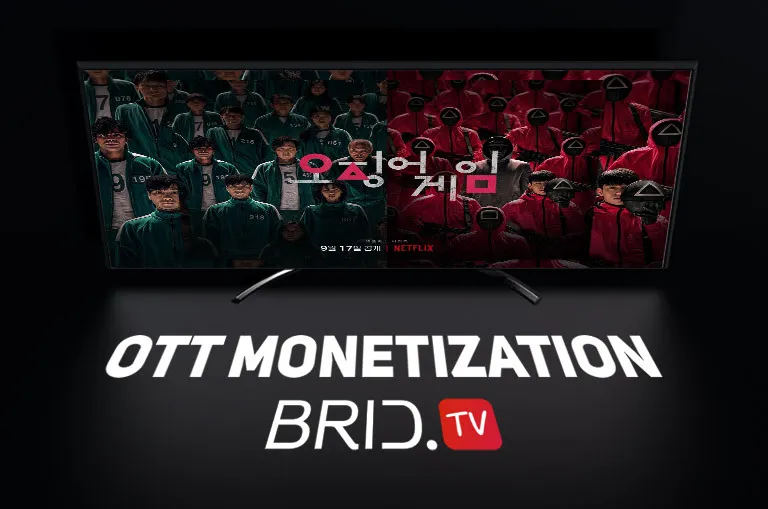Lately, more and more people have been cutting the cord and turning from traditional TV to live and on-demand video. The reasons are simple — internet-based video delivery is cheaper, more accessible, and offers better quality.
Thanks to the development of OTT technology and the booming OTT market, consumers have plenty of providers to choose from. There are hundreds of OTT streaming services out there, and each offers unique benefits, features, and content. And since more than 55 million people will switch from traditional TV to OTT TV by 2022, it’s guaranteed that the market will only keep growing.
With such a huge increase in OTT viewership, more and more publishers and streaming providers are entering the race by launching and monetizing OTT apps.
But how are publishers monetizing OTT services? What are the best OTT video monetization models out there? And how do you know you are ready to launch an OTT app? These are just some of the questions we’re going to address in this article.
So let’s begin by breaking down how OTT platforms make money.
How Do OTT Platforms Make Money?
If you regularly watch online videos, you’re likely aware of a few methods popular streaming and video-sharing platforms like YouTube and Twitch use to monetize their content (e.g., ads and subscriptions). However, unlike these websites, OTT platforms are private, not public services. That is why OTT providers need to find a secure, premium online video platform to monetize videos.
The platform you choose should have high-end security, advanced video monetization options, and easy integration with your OTT app. For instance, we at Brid.TV offer publishers complete Android, iOS, and tvOS SDKs, making integrations with all types of OTT apps seamless. That way, publishers can easily synchronize our video platform with their OTT service and leverage various video monetization options like ad pods, tag waterfalling, and video header bidding.
Alternatively, OTT platforms can create their own native players for their OTT app if they wish to keep everything in-house, but that requires more time and money. Regardless of whether you decide to make a custom HTML5 video player or go with an online video platform like Brid.TV, publishers will still have to pick the best monetization model for their needs.

Choosing the Best OTT Monetization Model for Your OTT App
There are five OTT monetization models publishers can choose from, including a hybrid one. Your decision should ultimately depend on your budget, target audience, and business goals, as each of these models has its strengths and weaknesses. Now let’s check out your options and analyze them in greater detail:
1. Ad-Supported Monetization (AVOD)
Ad-based monetization is one of the most popular video monetization models online, and the same applies to OTT. In fact, 51% of all OTT market revenue comes from AVOD. That should be a clear indicator of just how many publishers opt for this model.
There are many reasons AVOD is the most popular OTT monetization model. One of the biggest ones is that it has low customer acquisition costs because, unlike other models, it offers content for free. That makes it one of the best choices for new OTT providers, as it lets them draw in a broader audience.
Another great part of ad-supported monetization is that OTT marketing is particularly popular among advertisers. With so many people cutting the cord and switching to OTT, advertisers are looking for a way to reach them on new devices. That is why OTT advertising offers good CPM, allowing publishers to earn more from running ads on their OTT apps than, for instance, on YouTube.
However, this model also has two significant downsides. Likely the biggest one is that ad-based monetization can be quite interruptive to user experience. That means your audience may get frustrated and leave, especially if you overdo it. The best ways to minimize your viewer churn rate are to ensure you serve personalized video ads and adhere to Better Ads Standards. Always keeping user experience in mind is the key to succeeding with this monetization model.
Another downside to AVOD is that it requires a large viewership to be lucrative. In other words, you will need a substantial audience before you start making any considerable profit. The reason is that the AVOD’s revenue-per-viewer rate is much lower than with other models.
Regardless of these downsides, the ad-based monetization model is one of the best choices for new OTT providers focused on growing their audience quickly.
Pros:
- Users get free content
- Easier to grow an audience
- Low customer acquisition costs
- OTT advertising has good CPM
Cons:
- Interruptive to user experience
- Requires a large viewership to be lucrative
2. Subscription-Based Monetization (SVOD)
Subscription-based monetization is the OTT monetization model with the highest revenue-per-user currently, despite earning less than ad-based models (around 40% of global OTT revenue comes from SVOD). The way this model works is that users commit to paying a monthly fee for access to your content, meaning you can more reliably estimate your monthly earnings. It is also the go-to model for the biggest OTT providers on the market, which should speak volumes of its effectiveness.
One of the most notable reasons SVOD is so popular is that it’s the most lucrative model for publishers with large audiences due to its high revenue-per-user. Another appealing aspect is that it is one of the best monetization models for publishers with exclusive and original content. Having exclusives locked behind a paywall is an excellent motivation for users to subscribe as they cannot access that content anywhere else. That is the exact reason industry giants like Netflix and Disney+ made it big.
Unfortunately, providers without exclusives might have a harder time getting a dedicated user base with a subscription-based model. Similarly, smaller providers may have trouble growing their viewership with this model as fewer people would be willing to pay a relatively unknown brand.
With the above in mind, it’s clear that SVOD is best suited for larger, already established publishers and is the model that will pay off the most in the long run.
Pros:
- Delivers the best revenue-per-user
- The most lucrative OTT monetization model with large audiences
- Excellent for publishers with exclusive and original content
Cons:
- Makes growing an audience more challenging
- Harder to make work with small viewerships
3. Pay-Per-View Monetization (TVOD)
Pay-per-view monetization is an OTT monetization model that lets viewers purchase individual shows or movies they’d like to watch. This model works on the principle of one-time purchases, meaning users get unlimited access to on-demand content that they pay for. That makes TVOD a more cost-effective monetization model for users only interested in a select number of shows.
One of the best ways publishers can use this monetization model is to have exclusive or seasonal content. That way, they can charge a set fee for their most popular shows or even organize remote premiere screenings of the latest cinematic releases. These factors make TVOD one of the best supplementary monetization models, as using the pay-per-view model for premium content while monetizing the rest of your library with SVOD or AVOD is one of the best ways to maximize your OTT revenue.
TVOD does come with a few significant downsides, though. One of the most apparent ones is that smaller providers won’t be able to rely on it as their sole source of income. That is because publishers need to have large, loyal audiences to profit from TVOD as their sole means of monetization.
Another notable fault of this model is that retaining users can be challenging. That is because many people will come to your platform just for that one show they wanted to watch and never come back again. That further emphasizes how vital exclusive and unique content is to maintaining a steady cash flow with TVOD.
Although pay-per-view has its fair share of faults, it’s an invaluable addition to any publisher looking to explore a hybrid OTT monetization model.
Pros:
- Excellent for publishers with premium or seasonal content
- Effective monetization method for providers with large audiences
- The best model to use as a supplementary monetization strategy
Cons:
- Next to impossible to sustain for smaller publishers
- Requires you to have excellent brand loyalty
- Low user retention
- Requires investing in safe third-party payment integrations
4. Hybrid Monetization Model
A hybrid monetization model entails combining two or more of the models above. For example, publishers could be using an ad-based monetization model for their entire video library except for their premium shows, which they could hide behind a paywall. Some platforms may even combine all three of these models, like YouTube.
Out of all the ways to monetize your OTT app, the hybrid model is the most sustainable and lucrative long-term. Why? Because it is usable at all stages of your business development. When you’re just launching your OTT service and need to grow an audience, you can leverage the power of AVOD while only paywalling your premium content. You can then switch to a subscription-based model once you accrue enough viewership to maximize your revenue.
A hybrid monetization model is also flexible and one of the best ways to build rapport with your viewers. Giving your viewers an option to try your platform for free (with ads) and let them decide if they want to subscribe later is an excellent way to build trust with your audience. Maintaining a trustworthy relationship with your viewers is also a perfect way to incentivize them to purchase your premium content later down the line.
However, adopting a hybrid monetization model comes with a few challenges. The most notable one is that it requires extensive knowledge of the models you decide to incorporate. That means if you don’t have enough industry experience, you might have trouble handling all the necessary operations.
Another hurdle publishers may encounter with hybrid monetization models is that they are harder to maintain and require more third-party integrations to operate. From choosing a reliable OTT platform and video ad network to partnering with a secure payment processor, there’s a lot to invest in.
But despite the higher initial costs, hybrid models are your best bet if you’re looking to build a sustainable and profitable OTT business.
Pros:
- One of the most sustainable and lucrative models in the long run
- Strikes a great balance between positive user experience and income
Cons:
- Making hybrid monetization work requires deep knowledge of all the models used
- Creating and maintaining this model requires more resources and third-party integrations
5. Free Ad-Supported TV (FAST)
Free ad-supported TV (FAST) is an OTT monetization model that’s been gaining a lot of popularity as of late. This model is quite similar to AVOD in that it relies on ads as its main source of revenue. However, the primary difference between these two models is that FAST offers a combination of on-demand content and linear TV streaming.
Unlike AVOD, where users always choose when and what they want to watch, free ad-supported TV also hosts live content channels that serve scheduled content similar to traditional TV. This monetization model is the logical next step for many cable TV providers in their quest to get their offerings online.
The fact that FAST is a free, ad-supported model means it retains all the benefits and downsides of AVOD, but it caters to broader audiences who prefer the CTV experience. FAST channels are also similar to cable TV in that they often offer various thematic and niche content.
If you’re a broadcasting company or a cable TV provider looking to enter the OTT space, the free ad-supported TV monetization model is likely the best choice.
Pros:
- It’s reminiscent of the traditional cable TV experience
- Low customer acquisition costs
- Usually comes with dozens of different channels with unique programming
- Appeals to broader audiences (users who prefer the traditional CTV experience)
Cons:
- Requires a more complex infrastructure due to linear streaming
- Some users may find it interruptive
- FAST channels lack the flexibility of on-demand content
Which OTT Monetization Model Is the Best?
As we have already mentioned, each of these monetization models has its strengths and weaknesses and is best suited for different stages of your business development.
For instance, newcomers to the OTT market will likely have to start with an ad-based model to grow their viewer base. This model gives users the most incentive to try your service out, as it’s free. However, it will require you to find a reliable OTT advertising platform to partner with.
Alternatively, once you accrue a substantial audience, you might consider switching to a subscription-based model or a hybrid one to lock your premium content behind a paywall. These methods will prove more lucrative once you gain a substantial following.
With that in mind, taking on a hybrid monetization model will undoubtedly be the best choice for publishers. An ad-based monetization model will help you weather the early stages of your business, while implementing one of the other two (or both) later will help you maximize revenue once you make a name for yourself on the market.
However, if you wish to cater to users who prefer the traditional TV experience, experimenting with free ad-supported TV (FAST) is likely your best choice. This model will give you the option of providing the CTV experience online while also granting the flexibility of an on-demand service.
What to Look for in an OTT Monetization Solution
Once you settle on the monetization model you’ll go with, the next step is finding a reliable OTT platform that supports it. Unless you’re going to handle your OTT needs in-house and make everything from scratch, there are a few things you should look for when searching for an OTT monetization solution.
You Might Also Like: OTT vs. CTV — All the Differences Explained
1. Variety of Monetization Options
Depending on the monetization model you pick, you’ll need to ensure the OTT platform you choose supports it. That is particularly vital for publishers looking to adopt a hybrid monetization model.
When looking for an ad monetization solution, you should search for a platform with advanced monetization features like prebidding, ad podding, and similar. These can be valuable tools for maximizing your revenue.
For subscription-based and pay-per-view services, you’ll need to ensure your platform has the necessary integrations and secure payment processing. This infrastructure is essential if you’re going to rely on third-party services to handle your paywalling.
2. High-End Security
Secure video delivery is another essential component of every OTT platform worth its salt. Protecting your content from piracy is crucial if you want to avoid losing unnecessary revenue. That is why you should look for platforms with advanced security features like tokenized security or extensive DRM support.
3. Easy Integration With OTT Apps
The platform you choose should also be easy to integrate with your OTT app. The best and easiest way to do that is with an SDK. So depending on which OTT streaming devices you want to get your app on, you might want to have access to different SDKs.
For instance, we at Brid.TV give publishers access to Android, iOS, and tvOS SDKs, which allow easy integration with all android devices and android-operated Smart TVs, iOS mobile phones, and Apple TV. So if you’re looking to enter a broad OTT market, look for a platform with these functionalities.
You Might Also Like: The Benefits of OTT Broadcasting for Video Publishers
Is Starting an OTT Business Worth It?
The short answer is yes — starting an OTT business can be profitable for companies of all sizes. Regardless of whether you’re an enterprise looking to compete against the big OTT providers for a piece of this juicy market or an independent, niche creator, building an OTT app and monetizing it can pay off in the long run.
Large brands may want to invest in creating original shows and building a platform to compete with popular brands like Netflix, Hulu, or Disney+. In contrast, small entrepreneurs may want to make their services accessible to wider audiences with a niche OTT app. So whether you want to make an app to hold your online yoga classes or compete with the big shots for a piece of the live streaming market, there’s an OTT monetization model that can make it possible.
If you need a reliable ad-based OTT solution, Brid.TV can help you. Our platform offers state-of-the-art monetization options that can help you skyrocket your OTT ad revenue.
Publishers can easily integrate our platform with their OTT apps using our Android, iOS, and tvOS SDKs and start their own ad-supported OTT business. Check out our OTT solutions and get in touch with our team to get started.


